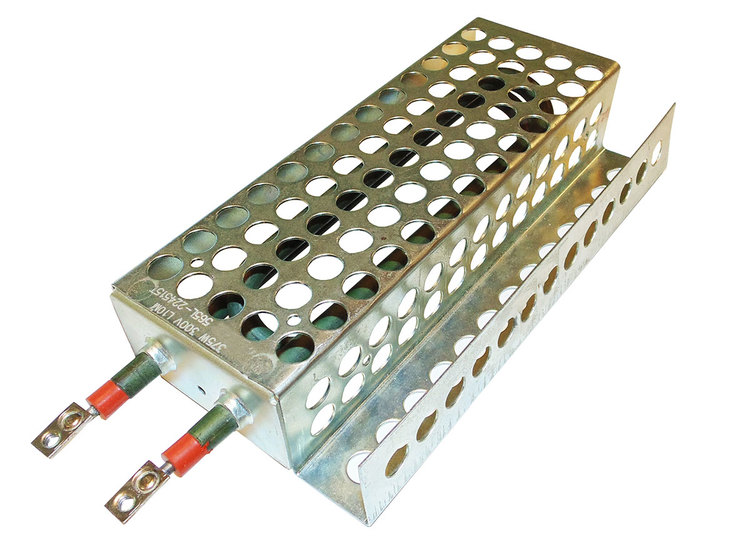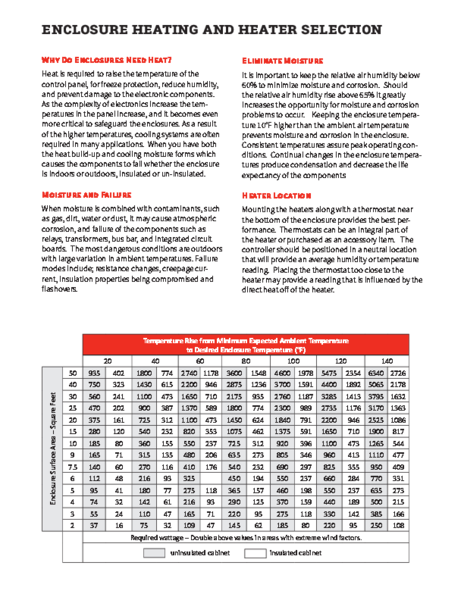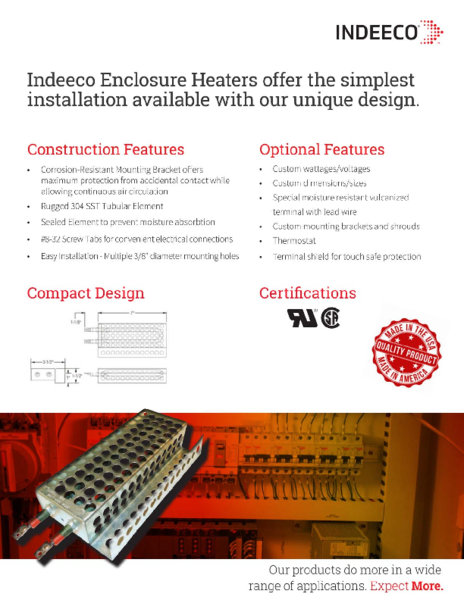HX Series Enclosure Heaters
Indeeco’s HX Series Enclosure Heaters offer a dependable heat source for maintaining temperature inside electrical enclosures. Designed with a compact form factor and a perforated mounting bracket, the HX Series allows for easy installation—making it an ideal replacement for failed strip heaters. These heaters help prevent condensation, protect sensitive components, and ensure consistent enclosure performance in challenging environments.
Approvals
Standard Features
Corrosion-resistant Mounting Bracket
Offers maximum protection from accidental contact while allowing continuous air circulation.
Easy Installation
Multiple 3/8″ diameter mounting holes.
Rugged 304 SST Tubular Elements
Withstand abusive handling and shipment.
Sealed Element
To prevent moisture absorption.
#8-32 Screw Tabs
For convenient electrical connection.
Compact Design
Most designs without thermostat are 3.5″ W x 1.5″ T x 8.125″ L
Optional Features
Custom wattages/voltages
Custom dimensions/sizes
Custom mounting brackets and shrouds
Thermostat
Enclosure Heaters
Moisture and Failure
When moisture is combined with contaminants, such as gas, dirt, water or dust, it may cause atmospheric corrosion, and failure of the components such as relays, transformers, bus bar, and integrated circuit boards. The most dangerous conditions are outdoors with large variation in ambient temperatures. Failure modes include resistance changes, creepage current, insulation properties being compromised, and flashovers.
Eliminate Moisture
It is important to keep the relative air humidity below 60% to minimize moisture and corrosion. Should the relative air humidity rise above 65% it greatly increases the opportunity for moisture and corrosion problems to occur. Keeping the enclosure temperature 10°F higher than the ambient air temperature prevents moisture and corrosion in the enclosure. Consistent temperatures assure peak operating conditions. Continual changes in the enclosure temperatures produce condensation and decrease the life expectancy of the components.
Heater Location
Mounting the heaters along with a thermostat near the bottom of the enclosure provides the best performance. Thermostats can be an integral part of the heater or purchased as an accessory item. The controller should be positioned in a neutral location that will provide an average humidity or temperature reading. Placing the thermostat too close to the heater may provide a reading that is influenced by the direct heat off of the heater.
Mounting Options
Enclosure Heaters
Supplied complete with mounting bracket. Bracket allows for installation by any one of numerous pre-punched holes. Heater can be installed horizontally or vertically. Unique design supports the element in a mounting flange allowing for expansion of the element independent of the shroud while allowing continuous circulation of air. Therefore, no stand offs, insulation, or special mounting hardware is required.
Typical Strip Heaters
Supplied with two mounting slots. This requires specific holes or bolts to install. Due to expansion of the heater the mounting bolts need be left loose to avoid buckling. Also, additional labor and materials are required to provide stand offs and/or insulation to disallow transfer of heat to the surface it is mounted to. All at additional cost.
Element Protection
Enclosure Heaters
Provide corrosion resistant shroud which offers maximum protection from accidental contact of heating element.
Typical Strip Heaters
Require additional fabrication installed around the heater (at additional cost) to provide protection from accidental contact of heating element.
Moisture Absorption
Enclosure Heaters
Use tubular element sealed at the ends which disallows moisture absorption. This maximizes heater life.
Typical Strip Heaters
Generally sheet metal with crimped seams the length of the heater. These seams many times allow for moisture to be absorbed by the hygroscopic insulating material resulting in premature failure. Expansion and contraction during operation exacerbates this problem over the life of the heater.
Heater Size/Shape
Enclosure Heaters
The unique design of the enclosure heater featuring a tubular element allows for the same bracket/shield for many different wattages. To increase the wattage the element length is increased and formed to fit within the shroud. The mounting footprint, price for the heater, and installtion cost stays consistent.
Typical Strip Heaters
To increase the wattage on a strip heater the size of the heater must increase to keep the same watt density. The heater must get longer, wider or both. This changes the mounting holes and requires additional fabrication for larger shields to protect the heater. All of this is at additional cost to the user.
Price/Cost
Enclosure Heaters
Consistently lower than strip heaters.
Typical Strip Heaters
Consistently higher than Indeeco Enclosure Heaters. Especially when considering extra added expense in mounting and protecting strip heaters.


